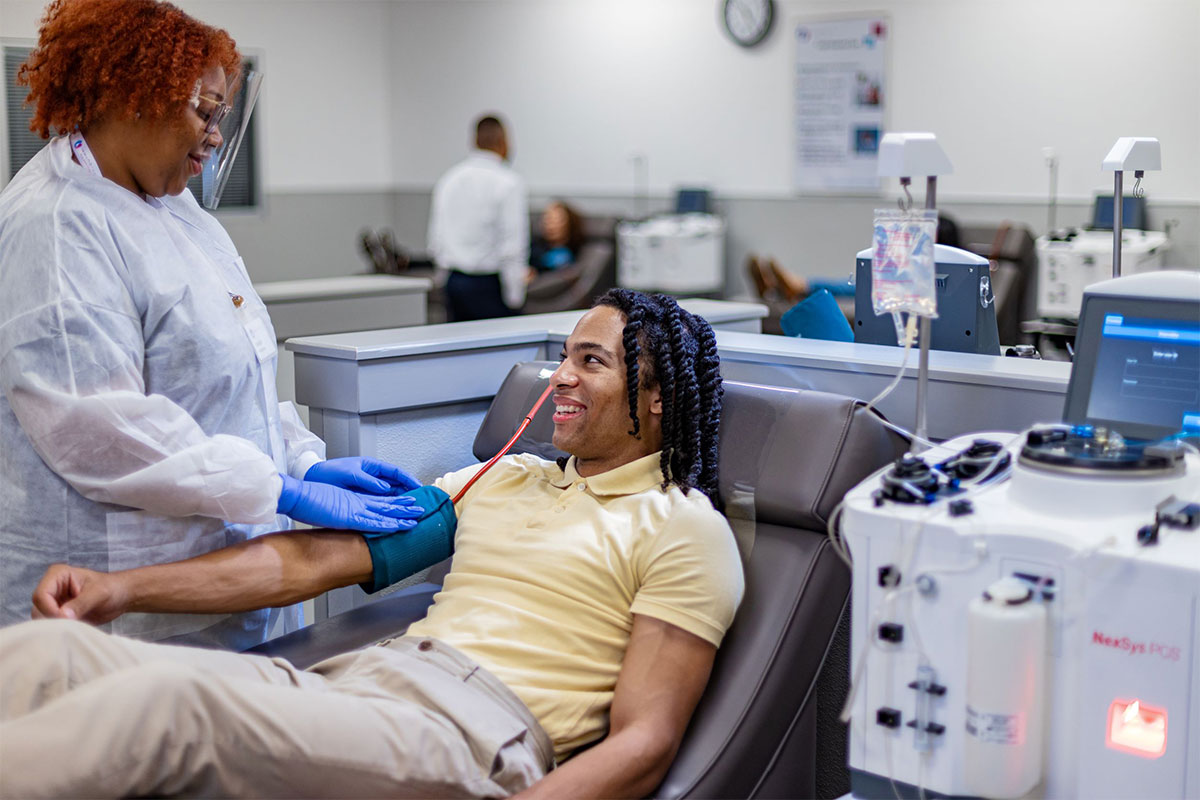Darryl Lorenzo Wellington’s rent was due, and he had insufficient funds in the bank to take care of it when he saw an advertisement offering him $50 if he donated his plasma at Biotest Plasma in Santa Fe, N.M. He went there, donated his plasma, and left feeling good about the pay and thinking he could do the same thing next month to pay for rent, possibly donating twice a week.
“But the following day my body received an impromptu schooling in the price tag of the world I had entered,” the journalist, artist and the 2021-23 poet laureate of Santa Fe, N.M., wrote in 2014 in a piece that the Economic Hardship Reporting Project supported. “It happened at about 5 o’clock the next (morning).”
“Unexpectedly, with no apparent cause or logical relationship to physical exertion, I felt my legs go rubbery,” he continued. “This was something more than ‘mild faintness’ and particularly disturbing because of the aspect of a random attack.”
“I suddenly felt so weirdly fatigued that I couldn’t stand on my feet. I barely reached the couch before I passed out for five hours straight.”
Plasma Donation Facility Opens in South Jackson
Plasma makes up 55% of the blood volume without the platelets, red and white blood cells, and South Jackson residents can now give theirs in exchange for hundreds of dollars per month at the newly opened ImmunoTek Plasma Center on Raymond Road.
In a June 17, 2022, press release, ImmunoTek Bio Centers LLC announced the opening of its 63rd facility, which started operations on June 22, 2022. The Louisiana-based company projects that the facility’s operations will help revitalize that part of the city. The pharmaceutical industry uses plasma to create products for treating different diseases, including immune deficiencies and bleeding disorders.

“The economic impact of a typical plasma donation center in a community is estimated at approximately $5 million per year,” the company said in the press release. “It is located in a part of Jackson that is undergoing revitalization, and the center’s leadership believes ImmunoTek Plasma will be a financial boost to the area.”
An ImmunoTek Plasma Center now occupies a building that housed the Super D drug store, which closed in 2008 “for lack of business,” WLBT reported at the time. Over the last several weeks, construction workers have transformed the old building.
A spokeswoman for the company, who works as a public-relations professional for the Louisiana-based marketing firm Deveney, sent the press release to the Mississippi Free Press and stated that the $5 million-per-year projected benefits include job creation and donor compensation. The spokeswoman declined to have her name disclosed.
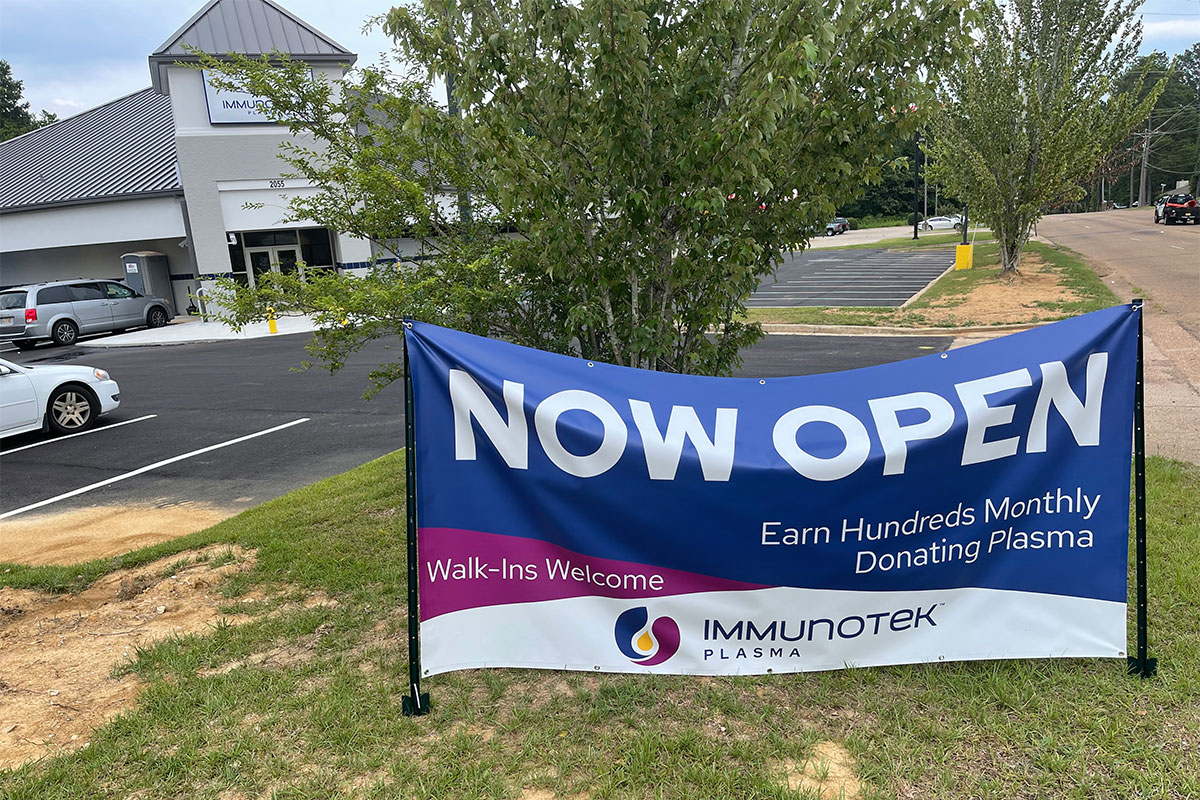
“So we are able to track that over the years of opening our centers,” she said during a phone interview on June 27, 2022. “And that’s been about what the average is for different communities; and we have them in multiple states in many, many different cities—so that number comes from looking at historical data for all of these different cities.”
ImmunoTek said in the June 17, 2022, press release that it has centers operating in 12 states, has 31 centers under construction, and is planning an additional 63 centers over the next three years.
Mayor: Looking ‘Forward to Many Years of Economic Success’
Jackson Mayor Chokwe A. Lumumba welcomed the company in an email to the Mississippi Free Press on June 29, 2022.
“We are very excited Immunotek Plasma has chosen a second Mississippi location in south Jackson and wish them the best moving forward,” he wrote. “We look forward to many years of economic success in their noble efforts to meet a worldwide need for donated plasma, which can be the difference between life and death.”
ImmunoTek Bio Centers LLC opened its first facility in Mississippi in October 2020 at Horn Lake in DeSoto County.
The Economist argued in a 2018 article that many developed countries ban paying people for their blood plasma, which creates a global dependence on its supply from the United States. Those who allow the practice permit less frequent donation.
“Plasma is used to make drugs such as factor VIII, which helps hemophiliacs’ blood to clot, and vaccines for rabies, tetanus and Rhesus disease,” the newspaper said. “Almost 50m (liters) of it were used in 2015, enough to fill 20 Olympic swimming pools.”

“America, the OPEC of plasma, produces 15 of those swimming-pool equivalents,” the newspaper added. “Forget steel and cars: plasma makes up 1.6% of America’s total goods exports.”
ImmunoTek Chief Operating Officer Blair McKinney explained that the United States supplies two-thirds of the world’s plasma, with demand increasing yearly.
“Plasma has a unique make-up, and it cannot be synthesized in a laboratory,” McKinney added in the press release. “The new center in Jackson is a way to help patients who depend on donated plasma for their quality of life, and will be an economic driver for the community.”
Treating Blood and Plasma Donations Differently
The Food and Drug Administration Agency requires that blood donated for money be marked as such but has no such requirement for plasma donation, statnew.com noted.
“Aside from the ickiness of handing out literal blood money, the FDA worries that paying donors would jeopardize the safety of the blood supply,” the health, medicine and life sciences journalism website added. “No one with a blood-borne illness is eligible to donate, but the agency worries that if money were on the line, donors might lie about their health or their risk behaviors.”
The website says that the FDA takes a different approach to plasma because it undergoes a different process. “The reason is that plasma collected this way never goes straight into another person,” statnew.com said. “It’s broken into many different protein products that will become pharmaceuticals.”
“Along the way, these components are processed to remove or kill any virus stowaways.”
‘Similar But Different’
The ImmunoTek Bio Centers LLC spokeswoman told the Mississippi Free Press that plasma donation is “similar but different to donating blood.”
“If you’ve ever gone to a blood center where you can donate blood, it’s similar to that, except they extract the blood from you. Then there’s a machine that’s all self-contained—it’s next to each individual bed—and they separate the plasma from the red and white blood cells that’s in your blood, and they put that back in you,” she said.
“From there, the plasma can be frozen, if need be, and then later that plasma is used to create medicine that people use all over the world for a variety of different illnesses and disorders,” she explained.

“Hospitals use it for transplant patients, cancer patients, burn victims, some people who have bleeding disorders, autoimmune diseases—there are a lot of different uses for plasma,” she added.
While the American Red Cross recommends plasma donation once every 28 days and up to 13 times a year, the Food and Drug Administration Agency determined that plasma donation can take place twice a week, but not more than once in a two-day period.
The FDA demands that the plasma center explain the risks to donors such as the risk of citrate anticoagulant, which prevents the clotting of the blood cells that return to the body after separation from plasma. The FDA wrote that the risks also include tingling lips or fingers or muscle cramping.
Medical historian Harriet A. Washington linked Wellington’s feeling of fatigue the next day after he donated plasma to sodium citrate, used to prevent coagulation of the blood cells. She explained that sodium citrate binds to calcium in the body, making it no longer available to the body, and some people have a strong reaction to that.
“We know that some people respond badly to sodium citrate,” Washington told Wellington. “The worst case is rare: extreme hypocalcaemia, which can be fatal.”
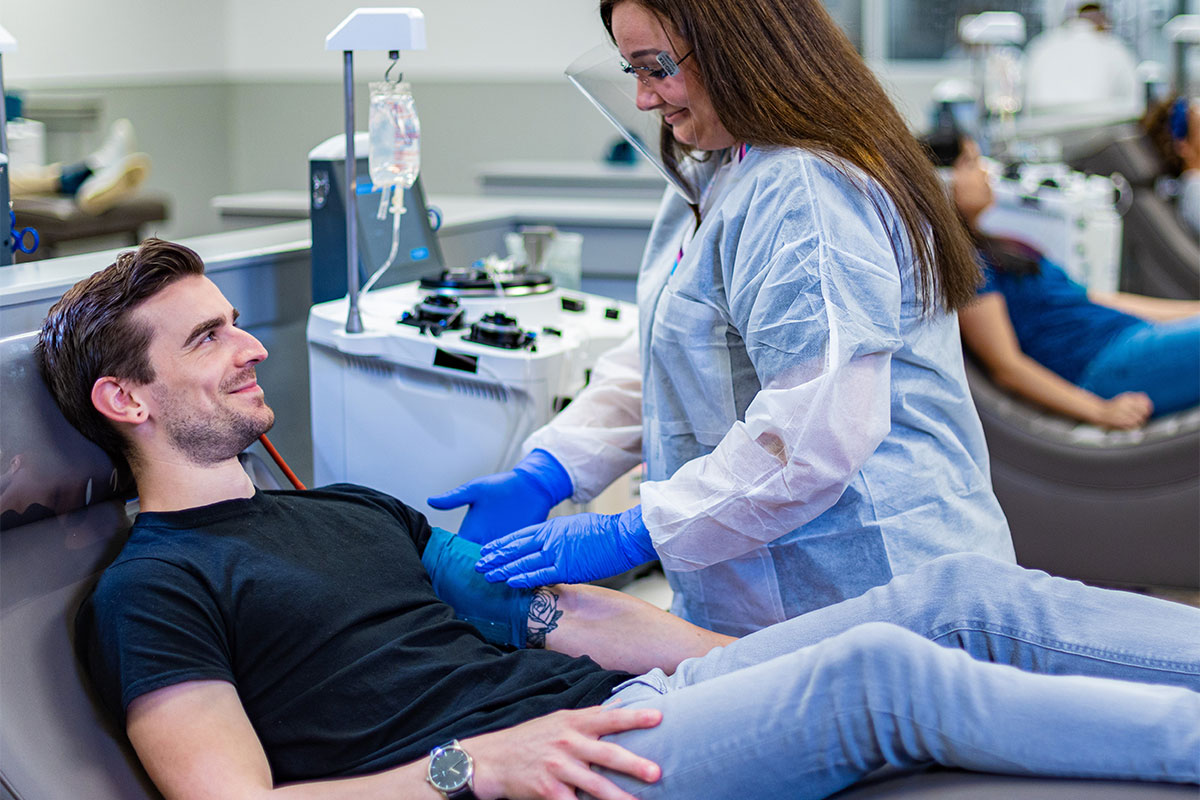
“But more often, people will suffer fainting, tingling and numbness, muscle contractions, or even seizures,” she added. “Walking around with depleted calcium can be extremely dangerous. It can lead to serious health-care issues.”
The FDA cautioned that people may manifest allergic reactions “such as flushing, itching, hives, abdominal cramps, difficulty breathing, chest pain, or bronchospasm, which may vary in severity from mild to life-threatening; nausea, vomiting, light-headedness, fainting, or seizures” as a result of donating plasma.
In the June 17 press release, ImmunoTek explained that it prioritizes safety. “Employee and donor safety are top priorities, (and) the company uses cutting-edge equipment and follows COVID-19 protocols to ensure a safe, clean, and comfortable experience for donors and employees alike,” the company wrote. “Following an in-house screening along with a medical history and physical exam conducted by medical professionals, donors can roll up their sleeves and donate plasma much the same way as a blood donation.”
“The donation process uses a sterile, self-contained, and automated process called plasmapheresis,” they added. “Plasma can be donated up to twice a week, and donors are compensated for the time spent while donating.”
The Intersection of Plasma Donation and Poverty
In a 2021 report, Business Insider noted that many Americans donate plasma as a financial lifeline. “In the 90 minutes it takes to donate, they make five times the federal minimum wage,” the news outlet added.
The website connectusfund.org agrees, adding that plasma donors get about $50 per extraction. “[S]ome pay more, some less,” the website added. “For many donors, the payment goes a long way in paying for food, rent, medicine, and other basic needs.”
Joseph Dupree, a Jackson State University and Belhaven University graduate, serves as the newly opened plasma facility director. Quotes from him in the June 17 press release emphasized the possible impact of the new center on the local economy. “This is a great environment for donors and employees,” he said. “We financially compensate donors for their time, and in turn, they spend their money supporting local businesses.”
“This new center will be a big boost to South Jackson,” Dupree added.
Dupree was the assistant center manager at CSL Plasma until early in 2022, when he joined ImmunoTek. CSL Plasma, which has two locations in Jackson and one in Gulfport, also offers cash for plasma donation.
Octaplasma, located in Greenville, Miss., does the same.
In a report exploring the intersection of poverty and the location of plasma-donation centers in 2017, ABC News noted that the U.S. supplies 94% of the paid plasma used around the world and that nearly 80% of the plasma centers in the U.S. are located in America’s “poorer neighborhoods.”
“Many of the people who frequent these centers to give their plasma are full-time workers and low-income Americans who are just unable to make ends meet,” the media outlet added.
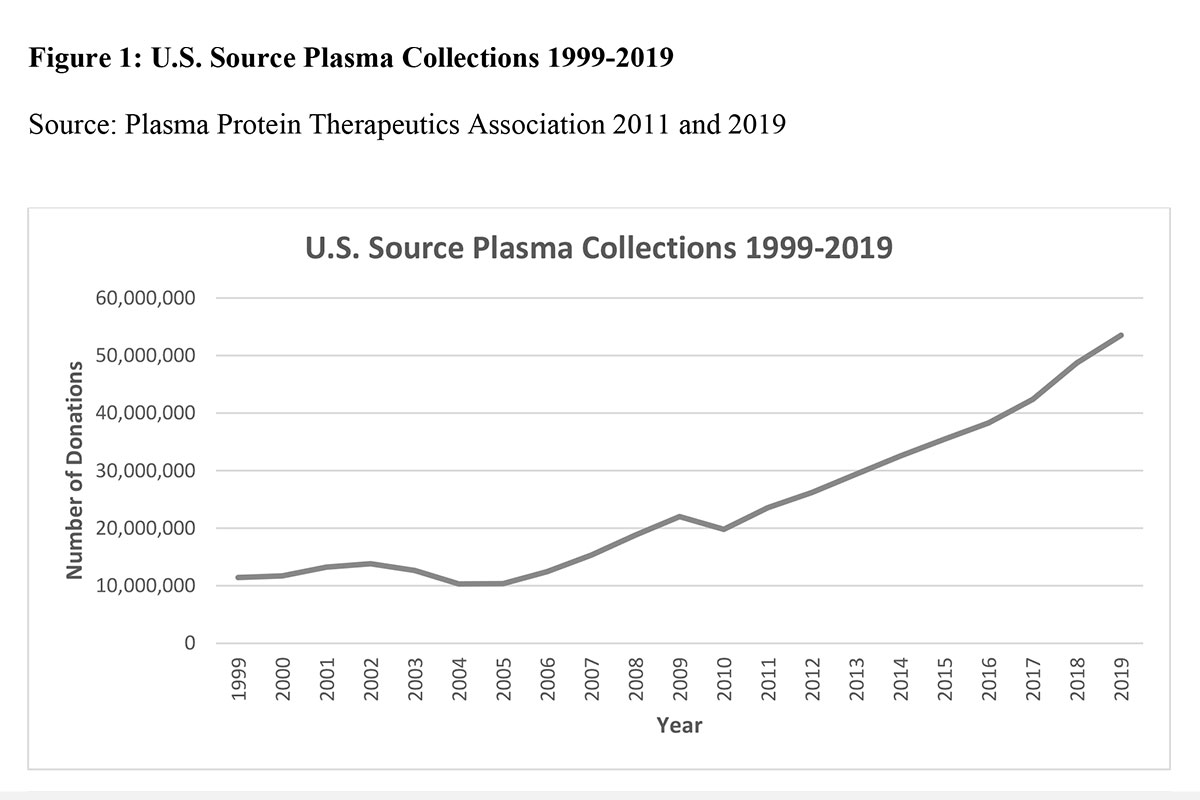
On June 28, 2022, when this reporter visited the new Immunotek Plasma Center location, a banner announced the facility’s opening and notified the public that they can earn hundreds of dollars monthly, with walk-ins welcome. During the visit, Dupree, the director, was leaving the facility after the day’s work and declined to speak with the reporter, citing a lack of green light from the headquarters in Louisiana.
The spokeswoman promised to facilitate the interview with someone from the company during the June 27 phone interview with the Mississippi Free Press. In an email to the Mississippi Free Press on June 29, 2022, she wrote, “Might you be available for a phone interview TOMORROW (Thursday)?”
But after answering affirmatively, the Mississippi Free Press could no longer get in touch with the spokeswoman. She did not return repeated calls and emails about the proposed interview between June 30 and July 5, 2022.
Link Between Plasma Donation and Poverty
Three University of Michigan researchers—Analidis Ochoa, H. Luke Shaefer and Andrew Grogan-Kaylor—revealed their findings in 2021 on the link between blood plasma donation and poverty from a nationwide survey. “Non-Hispanic Black people make up almost 21.5% of the population in census tracts with plasma centers, compared to 13.4% of those without plasma centers,” they wrote. “The results are similar for (people of) Hispanic origin.”
“In contrast, while 50.8% of residents in census tracts with plasma centers are non-Hispanic white, the proportion of non-Hispanic white residents is 12 percentage points higher in census tracts without plasma centers at 62.8%,” they added. “Those living in census tracts with plasma centers were also more likely to live in poverty, most noticeably deep poverty, below 50% of the poverty line, and 100% of the poverty line.”
“The rate of overall poverty was 51% higher in tracts with a plasma center than in tracks without plasma centers.”
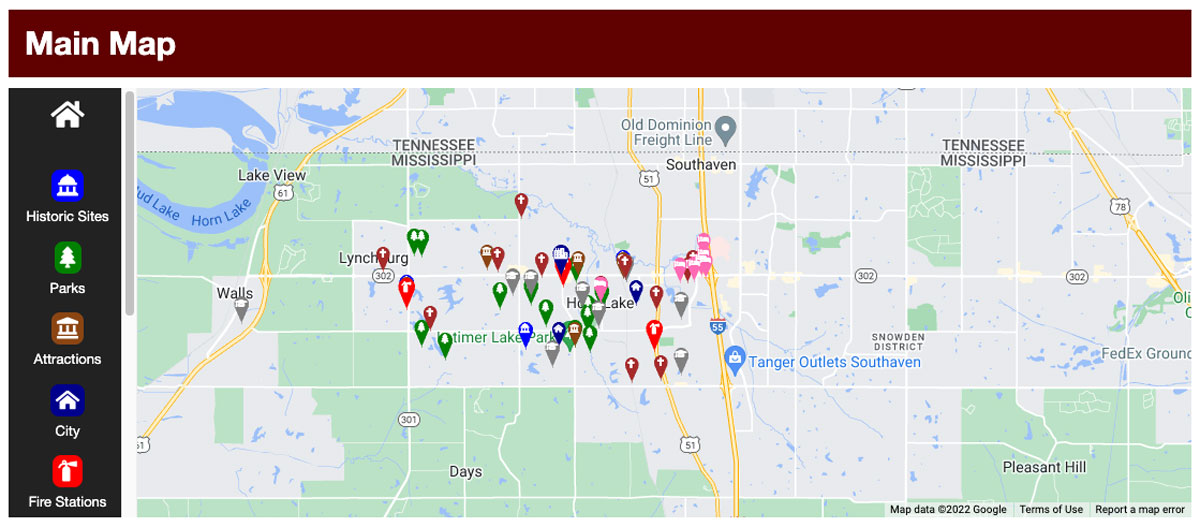
Both Horn Lake in DeSoto County, where Immunotek Plasma located its first facility in Mississippi, and Jackson, Miss., have poverty levels that are well above the national average, at 16.3% and 24.5%, respectively. The national poverty level is 11.4%, while the average poverty rate in Mississippi is 18.7%.
The spokeswoman for ImmunoTek Bio Centers LLC told the Mississippi Free Press about the company’s decision-making process behind the siting of new facilities.
“[U]sually what they do is they look for locations that have available real estate,” she said. “So they look at a lot of different numbers; they look at demographics; they look at proximity to large cities, sometimes colleges because college students frequently donate plasma.”
The University of Michigan researchers’ 2021 report noted the lack of information in the academic literature on the short- and long-term implications of plasma donation.
“Pharmaceutical companies that manufacture and profit from the sale of plasma protein therapies have little incentive to investigate this line of inquiry further; their focus is on the patient, not the donor,” they wrote. “While there is an abundance of scholarship that examines the benefits of plasma-derived products for patients, deeper examination of how plasma donation affects purveyors of the raw material that patients and pharmaceutical companies depend on is equally important.”

“However, the privatized nature of the pharmaceutical industry hinders access to donor data, hampering efforts for independent research in this area,” the researchers added. “Still, generating this kind of data is paramount to ensuring donors with low incomes are not inadvertently debilitating their bodies in an effort to combat their poverty.”
The FDA said plasma donors should not have less than 6 grams per 100 mL of serum protein in regular testing.
In the phone conversation with the Mississippi Free Press, the ImmunoTek Plasma Center spokeswoman explained that intending donors will go through a qualifying process. “When you come in to donate plasma, you go through a quick medical check to make sure that you are eligible to donate,” she said.
‘Everybody Lies’: Donors Use Tricks to Pass Tests
In his article published in The Atlantic, Darryl Lorenzo Wellington shared information he gleaned from people who regularly donate plasma. He referred to them as “plassers.” He described one as an alcoholic who was homeless and had been plassing for nearly 15 years, continually falling asleep on the couches and once collapsing in the standing line at CSL at Albuquerque, N.M.
He told Wellington that he was unhappy when he had been drinking too much to pass the protein level test, but the man claimed he later discovered how to game the test. “If I swallow ketchup before going in I can pass any test they throw at me,” the artist told Wellington. “Bubba was cognizant that donors who were homeless, alcoholic, or had suffered head injuries like his own were, in theory, barred,” the artist added.
“Everybody lies,” the plasser told Wellington. “Nobody is honest on all those questions.”

A woman told Wellington she puts on extra clothes to pass the weight limit of 110 pounds and knows regular plassers who use ankle weights to achieve the same end. Another told him he had had several blackouts, with one occurring while driving. “I had to pull over,” the respondent told Wellington. “I had to sit there several minutes in a daze. It really freaked me.”
Many of those he interviewed “lived in circumstances that made plassing a hardship, but said, ‘I can’t eat if I don’t plass,'” the artist added.
The nonprofit Immune Deficiency Foundation’s website, plasmahero.com, said the body replenishes donated plasma protein quickly. “The body replenishes plasma proteins and fluid quickly after a donation within 24-48 hours, making it safe to donate more frequently than a whole blood donation,” the organization’s website added.
“Just as there is no substitute for blood, there is no substitute for the therapeutic proteins that come from plasma.”
‘No Evidence of Harm’
The 2018 Economist article opposes the notion that paying for blood plasma preys on the poor. “It is possible that those selling plasma need the money and therefore might give too often,” the magazine said. “In America plasma donors can give twice a week; those in Europe can give just once a week.”
“There is no evidence of harm to their health in either case, but more long-term study would be prudent,” the newspaper added.
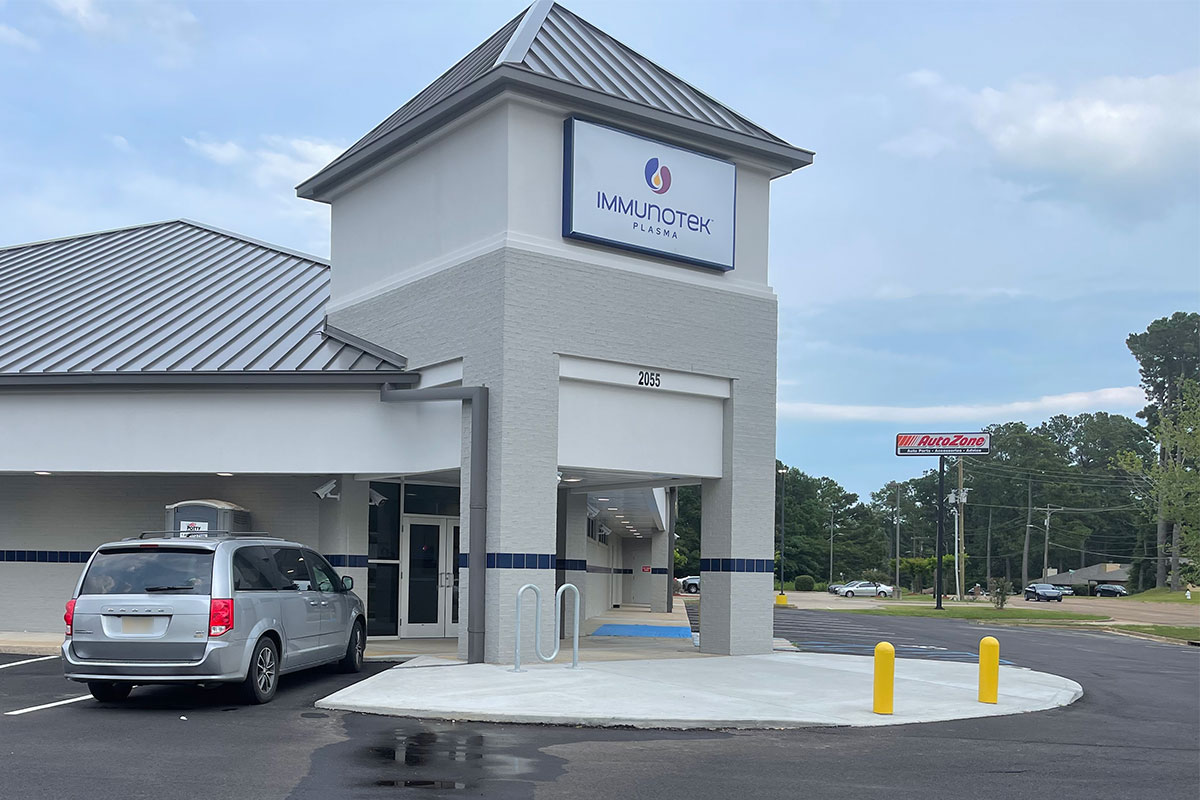
In last month’s news release, ImmunoTek Chief Operating Officer McKinney explained the importance of compensating donors. “For donors, plasma donation is an easy way to help others and earn extra money,” she said. “For patients with life-altering medical conditions, receiving donated plasma can mean the difference between life and death.”
The Economist explained that limiting plasma donation to voluntary donors is not practical because the countries that don’t allow such all end up importing from those who allow the practice. “And the fact that America is by far the dominant supplier carries risks of its own,” the newspaper continued. “The dependence on a single source leaves the rest of the world vulnerable to an interruption of supply.”
“To protect their people, therefore, other governments need to diversify their supplies of plasma,” the newspaper added. “Paying for it would make a big difference.”
Immunotek Plasma spokeswoman told the Mississippi Free Press that the estimated $5 million per year of economic impact from the new center is a projection from similar facilities.
“As the center becomes established after the first year or so, the people become regular donors; it is very common for our centers to have regular donors who come in twice a week routinely and make their donations,” she said.
“So we are able to track that over the years of opening our centers; and that’s been about what the average is—for $5 million a year for different communities.”

